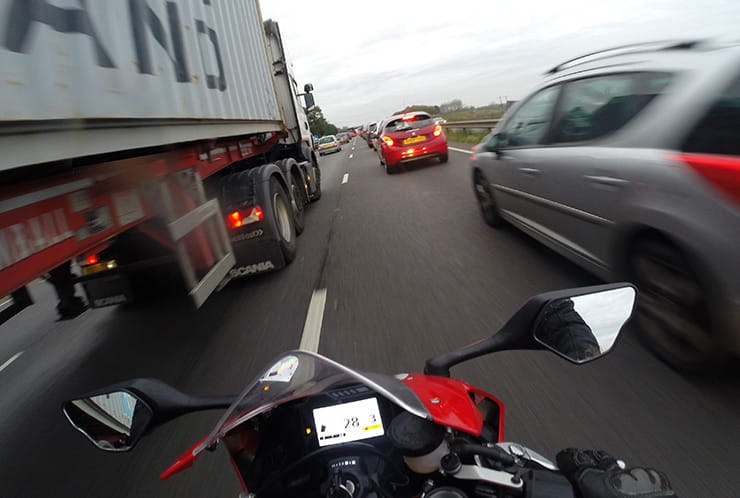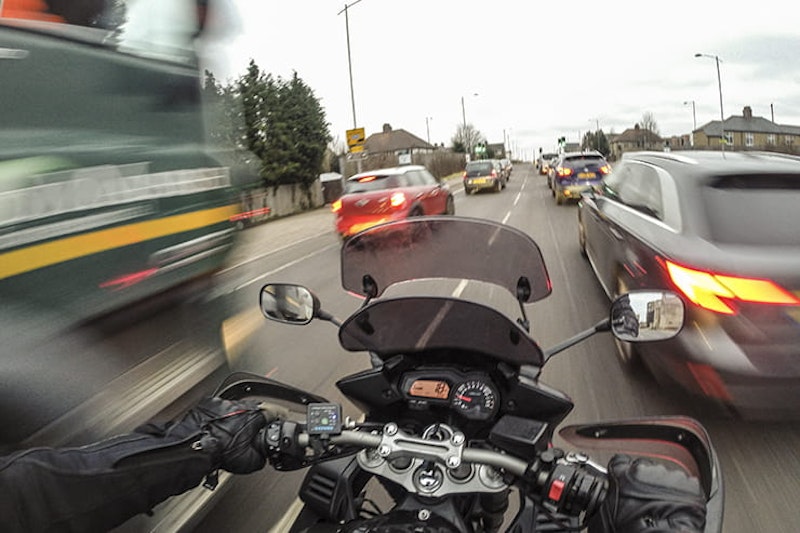Filtering on your motorcycle | The laws & Top tips
By Gary Baldwin
Director of Rapid Training
04.12.2017
As Britain’s roads become increasingly clogged, the ability to unobtrusively slice through snarl-ups is a godsend for anyone commuting on a bike. Why would you sit in a queue when you don’t have to? There are risks to filtering, but once you know what they are you’re well on the way to staying safe.
Can you filter through traffic?
Yes. Getting through traffic quickly is part of what a bike is for and I believe we should do it. It’s legal and there’s no reason why it should be dangerous provided you’re aware that other people might not be expecting you to be where you are.
Is it legal to filter on a motorcycle?
It is legal in the UK, but it’s a grey area. The Highway Code says “when filtering in slow-moving traffic, take care and keep your speed low” so it all depends on the definition of slow-moving and what speed is low. So, technically, you can’t say that filtering at 70mph is careless driving, but it’s important to consider if you’re being reasonable – if you’re hit when filtering, that’s what you’ll have to prove. If you’ve just overtaken a car going 10mph faster than them, they won’t bat an eyelid because it appeared reasonable to them. But if you went by 40mph faster, that’s when you might lose that reasonableness. And when you’re on your back staring at the sky, those people will be only happy to tell the coppers what they thought of your filtering.
What’s a safe speed to filter?
Filtering accidents are generally the result of an inappropriate speed differential, whether you’re filtering on the motorway or in town. You need to keep the difference between the cars and you as low as you reasonably can.
Filtering is all about keeping things sensible, and it’s not the speed number itself that matters, it’s the differential. You can’t say it’s safe to filter at 20mph or 50mph – it’s all about the difference. Personally, I’m happy doing 10-15mph more than the traffic filtering in slow motorway traffic, and a lot less than that in town.
The biggest error people make is going too fast at the wrong time. Filtering isn’t done at one speed - you should be altering it constantly depending on what the situation is. So when you’re coming up to junctions, entrances, exits and so on, you need to back off and wait and see – then 10mph could be much too fast. If there’s a gap you can’t see into, the car that’s about to stick its bonnet out can’t see you either. Beware.
Should I cover the front brake when filtering?
Personally, I don’t cover the front brake while filtering unless the situation is tetchy. Instead, I just use a responsive gear so there’s plenty of engine braking if necessary. But it’s down to personal feel.
Speed at around 18mph looks about right for the conditions, but our rider would be wise to stop filtering before the junction. That's when drivers can get erratic.
When shouldn’t I filter
Everyone has a point where they don’t want to filter any more. It depends on the conditions, but I tend think that at 50-60mph I’m happy to stop filtering and sit in the traffic. Some people are in much more of a hurry than that, which I’m not criticising provided the speed differential is sensible. So if you’re happy filtering at 70mph, don’t do it past cars doing 40.
What’s the most common filtering crash?
In town at junctions, often down to usual ‘courtesy causes confusion’ scenario. So you’re filtering past a line of slow moving traffic but you don’t notice that one of the cars has left a gap so someone in a side road can pull out and turn right. Someone waves them out and the first thing you see is their wing. You have to remember that they genuinely can’t see you when they pull out.
Occasionally we see them where a bike has filtered round the front of a lorry at a junction and is sitting right in front of it or by the nearside. You could hide a brass band in the blind spots at the front of a lorry – unless you’ve got eye contact with the driver, don’t go there. He’s got seven mirrors – by the time he’s checked them all, the situation in the first one has changed.
So motorways are safe filtering zones then?
No. On multi-lane roads, the common scenario is car drivers hanging out in lane three until the last possible minute and then deciding that they want to come off at this exit. They take a cursory glance in the mirrors, see a gap and dive across. Fundamentally, space is dangerous when you’re filtering because some toe-rag is inevitably going to try and make use of it. If the traffic has stopped and the spaces between cars have disappeared, you still can’t relax because there’s a risk that someone will open a door into your path.
Where do I filter on motorways? Between lane 2 and 3?
I think that between lanes two and three is the best place because my experience is there are fewer lane changes, though I’ve got no formal evidence of that. Also there’s usually more space because there are fewer lorries. I don’t like going between the off-side and the barrier because there’s a vibroline there that I don’t want to ride over and because of all the dead badgers, wing mirrors etc. Unless it’s absolutely stationary and you’re doing 10mph, that’s a no-no.
What speeds can I carry on filtering up to on motorways?
Everyone tends to have a speed at which they’re comfortable filtering at on multi-lane roads. There’s not a set number beyond which it’s dangerous - it’s down to personal judgement. Personally, once speeds get up to about 40 to 50mph I start to become slightly uncomfortable. If traffic is moving heavily in queues at 70mph and you want to dive down the middle, good luck. I’m not that brave any more.
Has that car pulled wide to let our rider through, or is it mid weave and about to close the gap? Thanks to the artic filling the lane, it all looks rather too close for comfort.
What’s the etiquette if another bike catches me up while filtering?
Let them pass as soon as you can. The fewer bikes there are around, the riskier filtering becomes because drivers won’t expect you. If there’s a good through-put of bikes, people tend to become bike aware. That’s why if a bike comes up behind me, I’m only too happy to let them pass. He can wake all the car drivers up and I’ll follow when they’re more aware - a bit selfish I know, but you make your own luck.
Anything else to bear in mind?
At night it’s worse because as a driver when you look in your mirror, what do you see? A load of lights. You just put your indicator on, you know there’s a gap and over you go. Or you don’t indicate – lots of drivers don’t. Another thing to consider is that at higher speeds, the cars can change lane faster.

